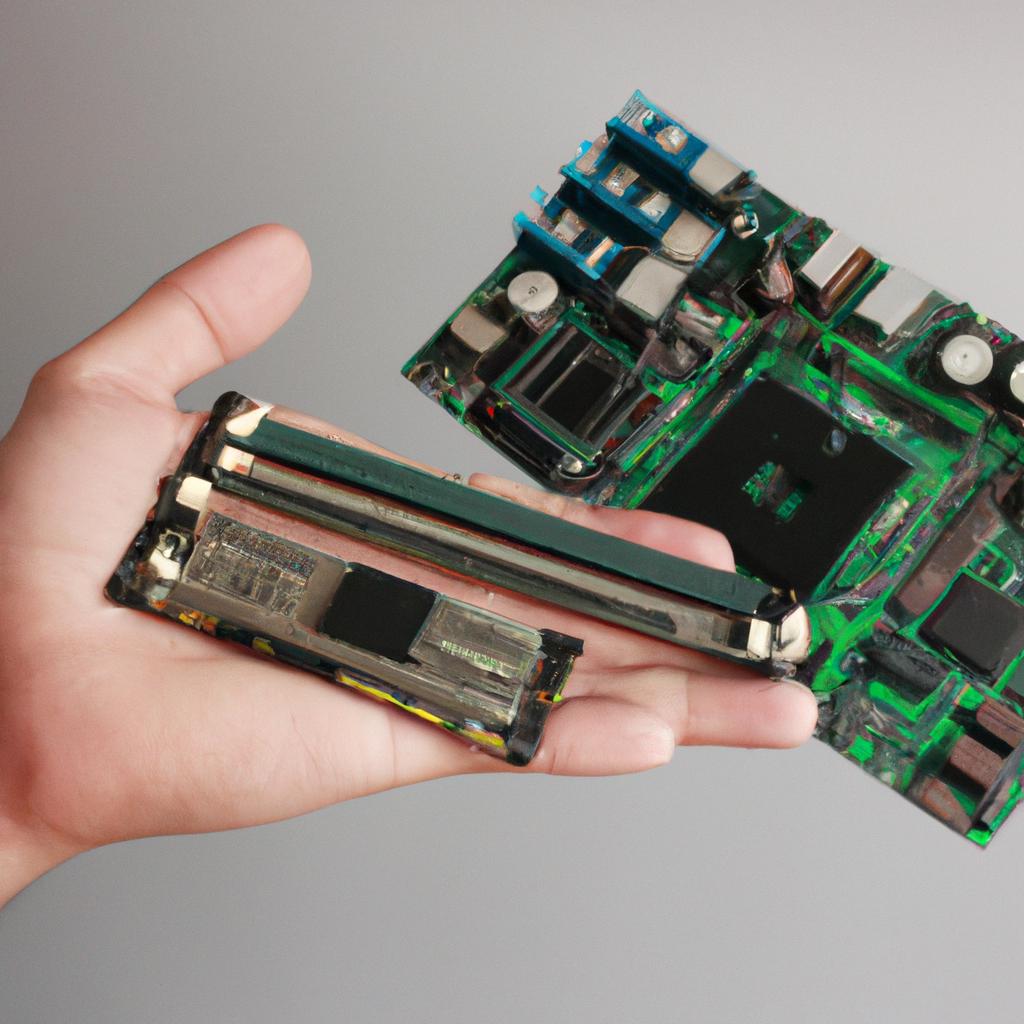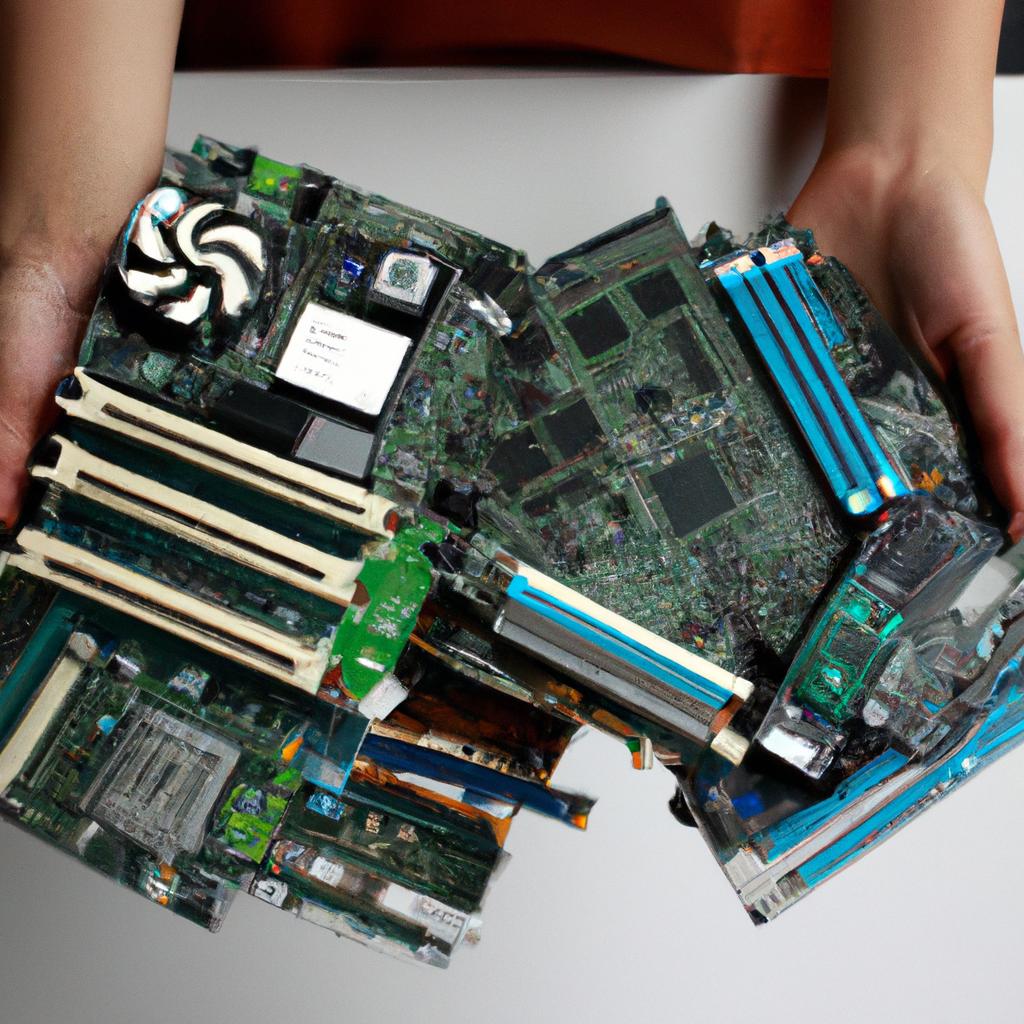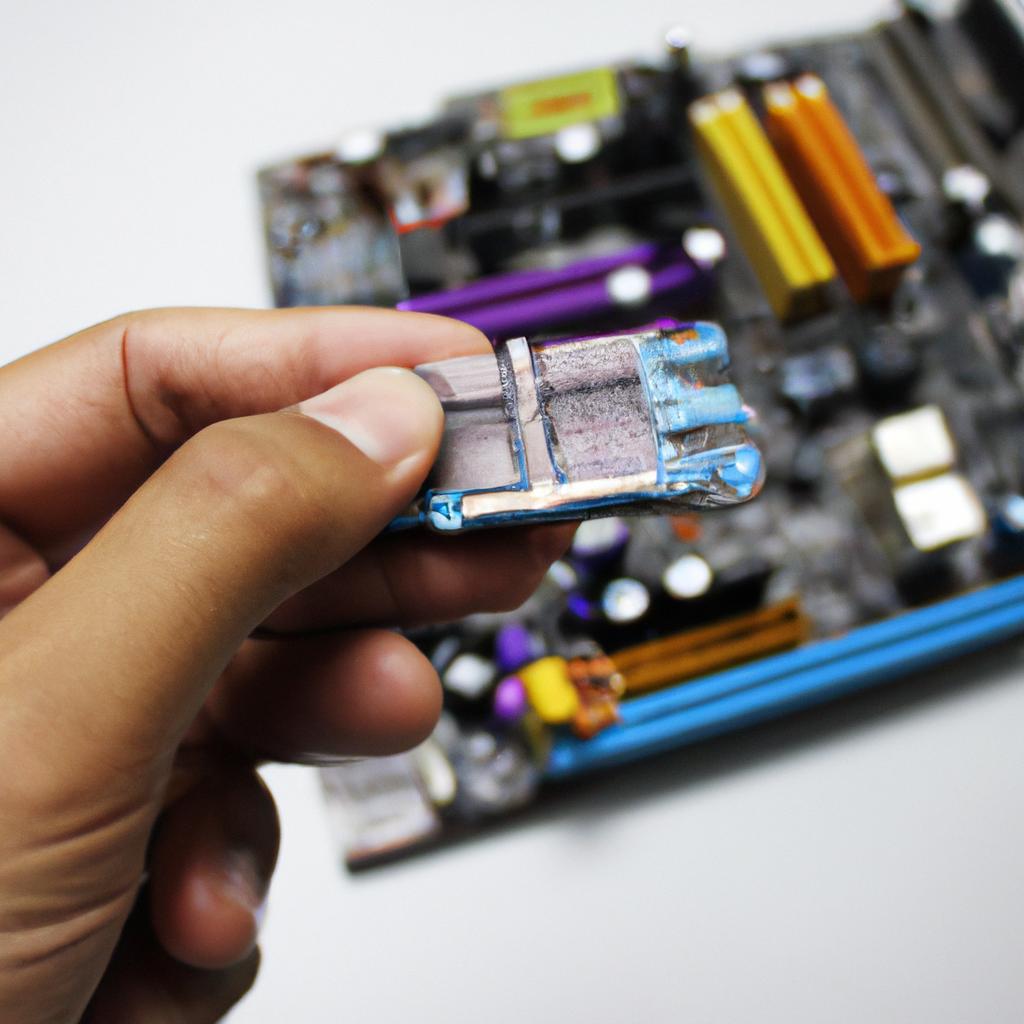The compatibility of computer hardware components is a critical factor to consider when building or upgrading a system. One such component that requires careful consideration is the socket, which serves as the interface between the processor and motherboard. In this comprehensive guide, we will delve into the intricacies of Socket AM3+, focusing on its compatibility with AMD platforms.
Imagine you have recently purchased a high-performance AMD processor for your gaming rig, only to realize that it does not fit into your existing motherboard. This frustrating scenario highlights the importance of understanding socket compatibility before making any purchases. Socket AM3+ is an essential platform offered by AMD, supporting numerous processors across different generations and architectures. By gaining a thorough understanding of the characteristics and features of this socket, users can make informed decisions about their upgrade path without encountering unnecessary setbacks or extra expenses.
Socket AM3+ offers backward compatibility with previous generation processors, allowing users to easily upgrade their systems without needing to replace both the CPU and motherboard simultaneously. However, despite this flexibility, there are certain limitations and considerations regarding specific CPUs and chipsets that potential upgraders should be aware of. This article aims to provide readers with an in-depth exploration of these factors related to Socket AM3+, offering valuable insight into its functionality and compatibility within various AMD platforms.
First and foremost, it is important to note that Socket AM3+ is specifically designed for AMD processors. This means that if you have an Intel processor or any other brand, it will not be compatible with this socket. It is crucial to ensure that the socket on your motherboard matches the exact specifications of your AMD processor.
Socket AM3+ supports a range of AMD processors from both the Bulldozer and Piledriver architectures. These include popular CPU models such as the FX-Series and Phenom II X4/X6/X8 processors. However, it is essential to check the compatibility list provided by your motherboard manufacturer to verify which specific CPUs are supported.
Furthermore, when considering compatibility within the Socket AM3+ platform, it is necessary to consider the chipset of your motherboard. The chipset acts as a bridge between the CPU and other components on the motherboard, providing various features and functionalities. Different chipsets may have varying levels of compatibility with certain CPUs.
For example, some older motherboards with Socket AM3+ may require a BIOS update in order to support newer CPUs based on the Piledriver architecture. This BIOS update can typically be obtained from the manufacturer’s website and applied before installing the new CPU.
It is also worth noting that while Socket AM3+ offers backward compatibility with previous generation processors, there may be limitations in terms of performance optimizations and features available on newer CPUs when used with older chipsets. Therefore, if you are planning to upgrade both your CPU and motherboard simultaneously, it is advisable to choose a motherboard with a chipset specifically designed for your desired CPU generation.
In summary, Socket AM3+ provides users with flexibility when upgrading their AMD systems by offering backward compatibility with previous generation processors. However, careful consideration should be given to specific CPU models and chipsets to ensure optimal compatibility and performance. Always refer to the documentation provided by your motherboard manufacturer for accurate information regarding supported CPUs and any necessary updates. By doing so, you can avoid compatibility issues and make informed decisions when upgrading your system.
Socket AM3+ Overview
Imagine you have a computer and want to upgrade its processor. You find yourself in a dilemma because the socket on your motherboard is incompatible with the latest processors available in the market. This issue is where Socket AM3+ comes into play – it offers an upgraded platform for AMD processors, ensuring compatibility and providing improved performance.
Socket AM3+ serves as a crucial interface between the central processing unit (CPU) and the motherboard. It enables seamless communication between these two components by offering specific physical features, such as pin layouts and power requirements. The enhanced design of Socket AM3+ expands upon its predecessor, Socket AM3, allowing users to harness higher computing power without replacing their entire system.
To better understand the significance of Socket AM3+, let’s explore some key features:
- Backward Compatibility: One notable advantage of Socket AM3+ is backward compatibility with older CPUs designed for sockets like AM2+ and AM3. This means that users can easily swap out their existing CPU for a newer one without having to purchase a new motherboard.
- Higher Power Delivery: Socket AM3+ introduces improvements in power delivery capabilities, enabling support for high-performance CPUs that demand more power to operate optimally.
- Enhanced Memory Support: With support for DDR4 memory modules, Socket AM3+ provides faster data transfer rates compared to its predecessors. This allows users to benefit from increased system responsiveness and multitasking capabilities.
- Overclocking Potential: Overclocking enthusiasts will appreciate Socket AM3+’s ability to push CPUs beyond their stock speed limits while maintaining stability under heavy workloads.
Now let’s take a closer look at how these features compare across different generations of AMD platforms using the following table:
| Backward Compatibility | Power Delivery | Memory Support | Overclocking Potential | |
|---|---|---|---|---|
| AM2+ | Limited | Moderate | DDR2 | Restricted |
| AM3 | Yes | Moderate to High | DDR3 | Improved |
| AM3+ | Yes | High | DDR4 | Enhanced |
In summary, Socket AM3+ offers a viable solution for those seeking to upgrade their AMD-based systems without requiring an entire overhaul. Its backward compatibility, improved power delivery, enhanced memory support, and overclocking potential make it a compelling choice for users looking to maximize the performance of their CPUs.
Moving forward, let’s delve into the key features that set Socket AM3+ apart in more detail as we explore “Key Features of Socket AM3+” section.
Key Features of Socket AM3+
To illustrate these points, imagine a scenario where you are building your dream gaming rig. You have carefully selected all the components, including a powerful AMD processor that is compatible with Socket AM3+. This compatibility ensures seamless integration between the CPU and motherboard, guaranteeing optimal performance for your gaming experience.
One of the notable strengths of Socket AM3+ lies in its extensive range of supported processors. Whether you require high-end CPUs for demanding tasks or more budget-friendly options for basic computing needs, this socket provides a wide selection to choose from. As an enthusiast, having such flexibility allows you to personalize your system according to your specific requirements without compromising on performance.
- Enhanced power delivery: The socket design incorporates improved power management capabilities, ensuring stable voltage supply to the CPU.
- Overclocking potential: With robust thermal control mechanisms and support for advanced overclocking techniques, enthusiasts can push their processors beyond their factory-set limits.
- Cross-generation compatibility: While Socket AM3+ primarily caters to AMD’s FX series processors, it also supports certain older generation chips like Phenom II X6/X4/X2 and Athlon II X4/X3/X2.
- Future-proof architecture: Even though newer sockets might emerge over time, investing in an AM3+ motherboard offers longevity as it remains relevant for several years after its introduction.
| Socket AM2/AM2+/AM3 | Socket AM3+ | Socket FM1/FM2 | |
|---|---|---|---|
| Year Introduced | 2006 (AM2), 2008(AM2+), 2009 (AM3) | 2011 | 2011(FM1), 2012(FM2) |
| CPU Compatibility | Athlon X4/X3/X2, Phenom II X4/X3/X2, etc. | FX series CPUs | APU processors |
| Memory Support | DDR2/DDR3 | DDR3 | DDR3 |
| Integrated Graphics | No | No | Yes |
This table helps highlight the key differences between Socket AM3+ and its predecessors, shedding light on the unique advantages of this particular socket version.
Moving forward to our next section about “Socket AM3+ vs Previous Socket Versions,” we will explore how this evolutionary step revolutionized AMD’s processor ecosystem, setting it apart from previous iterations.
Socket AM3+ vs Previous Socket Versions
Socket AM3+ vs Previous Socket Versions: An Evolutionary Comparison
Imagine a computer enthusiast who has been using an older generation AMD platform with socket compatibility issues. Frustrated by the limitations of their current setup, they decide to upgrade to the latest technology and opt for the Socket AM3+. This transition not only provides them with enhanced performance but also opens up new possibilities for their computing needs.
The introduction of Socket AM3+ marks a significant step forward in terms of compatibility and features when compared to its predecessors. Let’s explore some key differences that set this socket apart from previous versions:
-
Enhanced Power Delivery: One of the standout improvements is the increased power delivery capabilities offered by Socket AM3+. With more robust circuitry and support for higher wattage processors, it ensures better stability during heavy workloads or demanding gaming sessions.
-
Backward Compatibility: While introducing advancements, AMD has ensured backward compatibility with certain earlier processor models. This means users can seamlessly upgrade to Socket AM3+ without having to replace their existing CPU immediately, saving them both time and money.
-
Improved Memory Support: Socket AM3+ brings along improved memory support, allowing for faster data access and greater overall system responsiveness. The inclusion of dual-channel DDR3 memory enables smoother multitasking and enhances productivity across various applications.
-
Increased Overclocking Potential: For enthusiasts seeking additional performance gains, Socket AM3+ offers improved overclocking potential compared to its predecessors. With proper cooling solutions and compatible hardware configurations, users can push their systems beyond stock frequencies and achieve higher levels of performance.
Now let’s take a moment to delve deeper into these differences through the following table:
| Features | Socket AM2/AM2+/AM3 | Socket AM3+ |
|---|---|---|
| Power | Limited power delivery | Enhanced power delivery |
| Compatibility | Limited backward compatibility with older CPUs | Better backward compatibility with certain earlier processors |
| Memory Support | DDR2 memory support only | Dual-channel DDR3 memory support |
| Overclocking Potential | Limited overclocking potential | Improved overclocking potential |
As we can see, Socket AM3+ represents a significant upgrade compared to its predecessors. With enhanced power delivery, improved memory support, and increased overclocking potential, it offers users the opportunity to optimize their computing experience.
Moving forward, let’s explore the compatible processors for Socket AM3+ and understand how they further contribute to an efficient and seamless system setup.
Compatible Processors for Socket AM3+
Section H2: Socket AM3+ vs Previous Socket Versions
In the previous section, we explored the differences between Socket AM3+ and its predecessors. Now, let us delve deeper into understanding which processors are compatible with this socket. To illustrate, consider a hypothetical scenario where an individual wants to upgrade their existing system to support more advanced AMD processors.
One key advantage of Socket AM3+ is its backward compatibility with certain earlier sockets. This means that users can easily upgrade their systems without having to change their entire motherboard setup. However, it is important to note that not all processors from older generations will be supported on Socket AM3+.
To provide you with a clearer picture, here is a brief overview of compatible processors for Socket AM3+:
- AMD FX-Series Processors: These high-performance processors are specifically designed for Socket AM3+. With multi-core technology and impressive clock speeds, they offer enhanced performance capabilities for demanding tasks such as gaming and multimedia editing.
- AMD Phenom II Series Processors: Although originally developed for earlier versions like Socket AM2+, some models within the Phenom II series are also compatible with Socket AM3+. Users looking for value-oriented options may find these processors suitable for their needs.
- AMD Athlon II Series Processors: Similarly, some models within the Athlon II series can also be used with Socket AM3+. While not as powerful as the FX or Phenom II series, these processors provide decent performance at affordable price points.
- Other Compatible Processors: Apart from the above mentioned series, there might be other specific processor models from different generations that are compatible with Socket AM3+. It is recommended to refer to your motherboard’s documentation or official manufacturer website for an up-to-date list of supported CPUs.
Now let us take a moment to explore how upgrading to Socket AM3+ can enhance your computing experience by providing better processing power and improved compatibility. Here is a table that highlights some of the benefits:
| Benefit | Description |
|---|---|
| Enhanced Performance | Socket AM3+ supports high-performance processors, allowing for faster and smoother multitasking capabilities. |
| Future-Proofing | By upgrading to Socket AM3+, you ensure compatibility with newer AMD processor generations, extending the lifespan of your system. |
| Improved Gaming Experience | With powerful FX-Series processors, gamers can enjoy better frame rates and more immersive gameplay. |
| Overclocking Potential | Some Socket AM3+ motherboards offer advanced overclocking features, enabling users to push their CPUs beyond stock speeds for increased performance. |
In summary, Socket AM3+ presents an opportunity to upgrade existing systems by providing support for compatible AMD processors from different series. This ensures improved performance and future-proofing capabilities for users seeking enhanced computing experiences.
Moving forward, let us now explore the process of upgrading to Socket AM3+, as well as considerations to keep in mind during this transition.
Upgrading to Socket AM3+
Transitioning from the previous section, where we discussed the compatible processors for Socket AM3+, it is now essential to delve into the compatibility considerations associated with upgrading to this socket. To illustrate, let’s consider a hypothetical scenario wherein an individual is contemplating upgrading their existing AMD platform to support Socket AM3+.
Before proceeding further, it is crucial to understand that such upgrades involve not only replacing the motherboard but also other significant components like RAM and potentially power supply units. Therefore, assessing compatibility becomes imperative in order to ensure a successful transition. Here are some key factors one should consider when making this decision:
-
Processor Compatibility: The first step involves determining whether your current processor will be supported on the new Socket AM3+ motherboard. While some older AMD processors may be compatible, it is advisable to consult the manufacturer’s documentation or website for confirmation.
-
Memory Support: Upgrading to Socket AM3+ often necessitates transitioning from DDR2 memory modules (used in earlier sockets) to DDR3 modules. It is important to check if your system supports DDR3 memory before investing in a new motherboard.
-
Power Supply Unit (PSU): Since newer motherboards might require more power due to advanced features and capabilities, it is essential to verify whether your existing PSU can handle the increased demand. If necessary, upgrading the PSU may be required.
-
Expansion Slots and Connectors: Another aspect of compatibility consideration involves examining expansion slots and connectors available on both old and potential new motherboards. Ensuring that all necessary peripherals can still be connected without issues is vital.
To provide a visual representation of these considerations, here’s a table summarizing various elements related to upgrading to Socket AM3+:
| Component | Current Setup | Potential Upgrade |
|---|---|---|
| Processor | AMD Phenom II X4 965 Black Edition | AMD FX-8350 |
| Memory | DDR2 8GB (4x2GB) @800MHz | DDR3 16GB (4x4GB) @1600MHz |
| PSU | 600W | 750W |
| Expansion Slots | PCIe x16, PCI | PCIe 3.0 x16, PCI |
Considering these compatibility factors and evaluating your unique requirements will help determine whether upgrading to Socket AM3+ is the right choice for you. By carefully assessing each aspect of compatibility, you can make an informed decision that ensures a smooth transition towards a more powerful AMD platform.
Transitioning into the subsequent section on the “Future of Socket AM3+”, it is important to explore how this socket has evolved over time and what advancements may lie ahead.
Future of Socket AM3+
Upgrading to Socket AM3+ offers users a range of advantages, as explored in the previous section. In this section, we will delve into the future prospects and potential developments for Socket AM3+. By examining emerging trends and considering past advancements within AMD’s platform socket compatibility, we can gain insights into what lies ahead.
To illustrate the possibilities that lie before us, let’s consider a hypothetical scenario. Imagine a computer enthusiast who has been using an older AMD processor with Socket AM2+. This individual decides to upgrade their system by transitioning to Socket AM3+, seeking improved performance and compatibility with newer technologies. With their new motherboard supporting Socket AM3+, they are now able to install one of AMD’s latest processors designed for this socket, resulting in significantly enhanced processing power and efficiency.
Looking forward, there are several key factors that suggest promising prospects for Socket AM3+. Firstly, it is essential to acknowledge the ongoing commitment from AMD towards developing innovative solutions for its platforms. The company continues to invest in research and development efforts aimed at improving performance, energy efficiency, and overall user experience within its sockets. This dedication ensures that Socket AM3+ remains relevant amidst evolving technological landscapes.
Furthermore, industry trends indicate increasing demand for high-performance computing systems capable of handling resource-intensive applications such as gaming or multimedia editing. As these demands continue to grow, manufacturers like AMD strive to meet them by introducing more robust processors compatible with existing sockets like Socket AM3+. This not only provides cost-effective options for end-users but also allows them to maintain compatibility while enjoying enhanced capabilities.
In addition to these points, here is a list summarizing why upgrading to Socket AM3+ holds significant value:
- Enhanced processing power and efficiency.
- Compatibility with newer technologies.
- Cost-effective solution through maintaining compatibility.
- Future-proofing your system against upcoming advancements.
To further emphasize the benefits of moving towards Socket AM3+, let’s take a look at the following table that compares the features of different AMD platform socket compatibilities:
| Socket Type | Key Features | Advantages |
|---|---|---|
| AM2+ | Older technology | Limited compatibility with newer processors |
| AM3 | Improved performance | Compatibility with a wider range of processors |
| AM3+ | Enhanced processing power | Compatibility with the latest technologies |
As we approach the end of this section, it becomes evident that upgrading to Socket AM3+ not only opens up opportunities for improved performance and compatibility but also ensures future readiness. The ongoing commitment from AMD towards enhancing its platforms, combined with increasing demand for high-performance computing systems, suggests a promising outlook for Socket AM3+. By embracing these advancements, users can stay at the forefront of technological progress and unlock new possibilities in their computing experiences.




